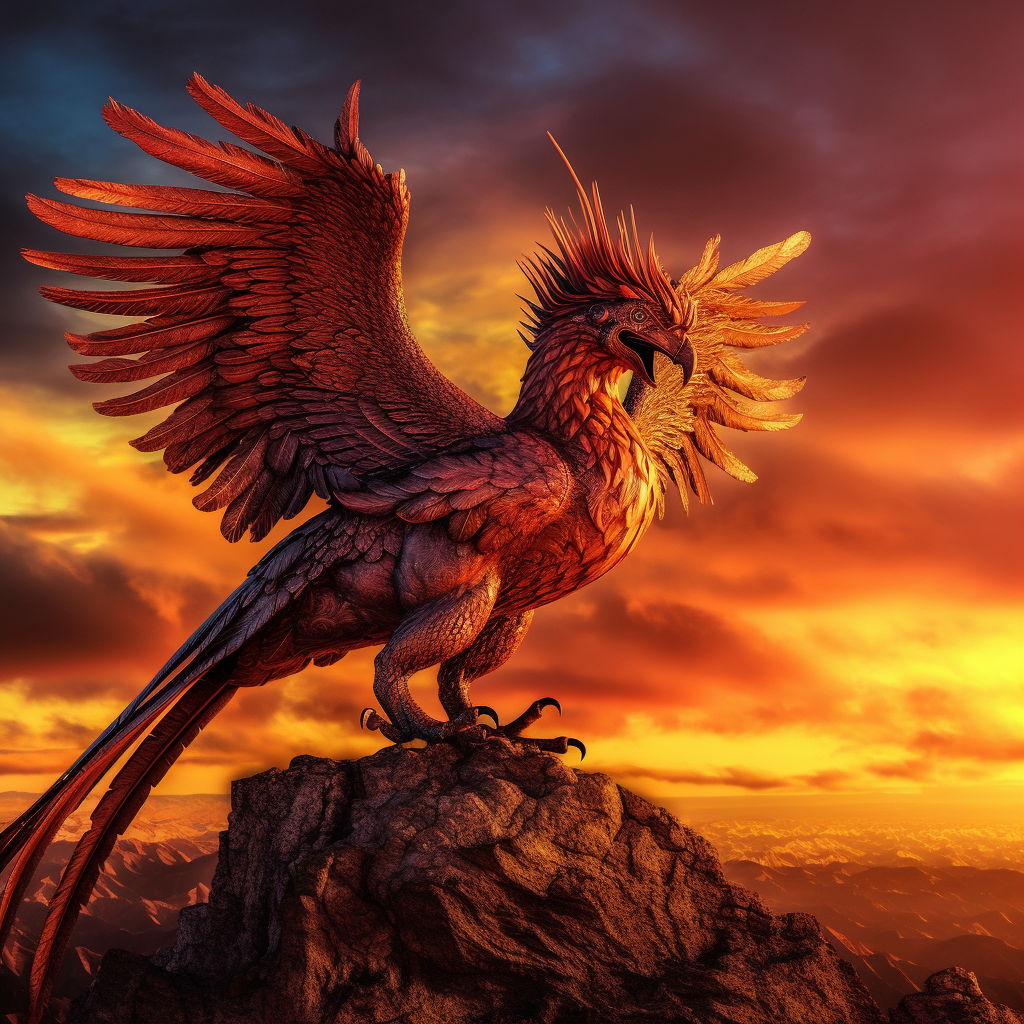The Phoenix is a mythical bird that has fascinated people for centuries.
It has been mentioned in many cultures and religions, from ancient Egypt to Greek mythology.
The Phoenix is known for its ability to rise from the ashes, which has made it a symbol of rebirth and renewal.
According to legend, the Phoenix was a magnificent bird with colorful plumage that lived in Paradise.
It was said to be a land of unimaginable perfection and beauty, beyond the brilliance of the sun.
The Phoenix was one of the creatures who lived in Paradise and enjoyed a good life.
The Phoenix’s story has been passed down through the generations, and it has become a symbol of hope and inspiration.
It has been featured in many works of art and literature, and its legend continues to capture the imagination of people around the world.
In this article, we will delve into the history, stories, and symbolism of the Phoenix, exploring what makes it such a fascinating and enduring creature.
Origins and Mythology
The Phoenix is a mythical bird that is known for its ability to rise from its own ashes.
Its origins and mythology are steeped in ancient history and have been passed down through generations.
In this section, we will explore the different mythologies that have contributed to the story of the Phoenix.
Greek Mythology
In Greek mythology, the Phoenix is said to have originated from the lands of Arabia.
It was a majestic bird with red and gold plumage that lived for 500 years.
At the end of its life, the Phoenix would build a nest of cinnamon twigs and set itself on fire.
From its ashes, a new Phoenix would rise, and the cycle would begin again.
The Greeks believed that the Phoenix was a symbol of resurrection and rebirth.
Other Mythologies
While the story of the Phoenix is most commonly associated with Greek mythology, other cultures have their own versions of the myth.
In ancient Egypt, the Phoenix was known as Bennu and was associated with the sun god, Ra.
The Egyptians believed that the Phoenix represented the cycle of life, death, and rebirth.
In Islamic mythology, the Phoenix was identified with the ʿanqāʾ, a huge mysterious bird that was originally created by God with all perfections but thereafter became a plague and was killed.
The Chinese also have their own version of the Phoenix, known as Fenghuang, which is a symbol of good fortune and prosperity.
Overall, the Phoenix is a mythical creature that has captured the imaginations of people throughout history.
Its story has been adapted and retold in many different cultures, but the underlying theme of resurrection and rebirth remains a constant.
Symbolism and Meaning
Religious and Spiritual Significance
The Phoenix is a powerful symbol in many religions and spiritual traditions.
In ancient Egyptian mythology, the Phoenix, known as Bennu, was associated with the sun god Ra and was seen as a symbol of resurrection and eternal life.
In Christianity, the Phoenix is associated with the resurrection of Jesus Christ and is often used as a symbol of the resurrection of the soul.
In Hinduism, the Phoenix is known as Garuda and is associated with the god Vishnu.
Garuda is seen as a symbol of power, speed, and freedom, and is often depicted carrying Vishnu on his back.
In Buddhism, the Phoenix is associated with the concept of rebirth and is seen as a symbol of the cycle of life, death, and rebirth.
Cultural Significance
The Phoenix is a popular symbol in many cultures around the world.
In Chinese mythology, the Phoenix is known as Fenghuang and is associated with the Empress and the feminine.
Fenghuang is often depicted with the dragon, which represents the Emperor and the masculine, and together they represent balance and harmony.
In Greek mythology, the Phoenix is known as a powerful bird that is reborn from its own ashes.
The Phoenix is often associated with the sun and is seen as a symbol of immortality and renewal.
The Phoenix is also associated with the god Apollo, who was often depicted riding a chariot pulled by Phoenixes.
In Native American cultures, the Phoenix is known as a powerful symbol of rebirth and renewal.
The Phoenix is often associated with the Thunderbird, which is seen as a symbol of power and strength.
The Thunderbird is also associated with the four elements of earth, air, fire, and water, which represent balance and harmony in nature.
Depictions in Art and Literature

Visual Arts
The Phoenix has been a popular subject in visual arts for centuries.
In ancient Egyptian art, the phoenix was depicted as a heron bird and was associated with the god Osiris.
It was often shown with outstretched wings and a halo of flames, symbolizing its fiery nature.
During the medieval period, the phoenix was commonly depicted with a halo, emphasizing its connection with the sun.
The bird was often shown with seven rays emanating from its halo, similar to the Greek personification of the sun, Helios.
In modern times, the phoenix has been depicted in various forms, from realistic paintings to abstract sculptures.
It has been used as a symbol of rebirth, renewal, and transformation in many different artistic styles and mediums.
Literature
The Phoenix has been a popular subject in literature for thousands of years.
In ancient Greek mythology, the phoenix was said to be a bird that lived for 500 years before burning itself to ashes and being reborn from those ashes.
In medieval European literature, the phoenix was often associated with Christian symbolism, representing the resurrection of Christ. It was also used as a symbol of hope and renewal.
More recently, the phoenix has been featured in many popular works of literature, including J.K. Rowling’s Harry Potter series and Suzanne Collins’ Hunger Games trilogy.
In these stories, the phoenix is often used as a symbol of hope and resistance against oppression.
Modern Interpretations and References
The phoenix has been embraced by popular culture and has become a symbol of rebirth and renewal.
Its symbolism has been referenced in various forms of media, from literature to music to movies. Here are some examples:
- The band Thirty Seconds to Mars has a song titled “Phoenix” that references the bird’s ability to rise from the ashes.
- The Harry Potter series features a phoenix named Fawkes, who has healing powers and can burst into flames and be reborn from its ashes.
- The Marvel Comics character Jean Grey, also known as Phoenix, has the power of telekinesis and can control fire.
The Phoenix has also been used as a symbol in various organizations and institutions:

| Organization | Meaning |
|---|---|
| University of Chicago | The phoenix represents the university’s rebirth after the Great Chicago Fire of 1871. |
| Phoenix Suns NBA team | The team’s name and logo feature a stylized phoenix, symbolizing the city of Phoenix’s rise from the ashes of a previous city. |
| Phoenix Society for Burn Survivors | The phoenix represents the resilience and transformation of burn survivors. |
The phoenix’s enduring popularity in modern culture speaks to its timeless message of hope and renewal.
Its ability to rise from the ashes has inspired people for centuries and will continue to do so in the future.
Conclusion
The Phoenix is a mythical bird that has captured the imagination of people for centuries. It is a symbol of rebirth, renewal, and immortality.
Throughout history, the Phoenix has been depicted in art, literature, and mythology.
Its story has been told in different cultures around the world, from ancient Egypt to modern-day Japan.
The Phoenix has been used as a metaphor for many things, including the cycle of life and death, the triumph of good over evil, and the resilience of the human spirit.
Today, the Phoenix continues to inspire people in many ways. Its story reminds us that even in the face of destruction and despair, there is always hope for a new beginning.
The Phoenix represents the power of transformation and the strength of the human spirit to rise from the ashes of adversity.

